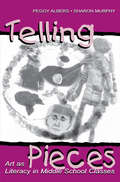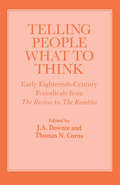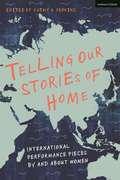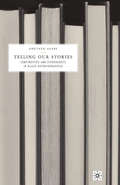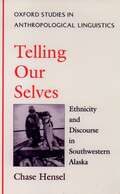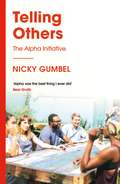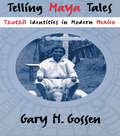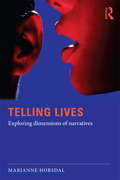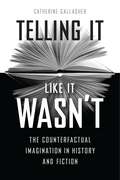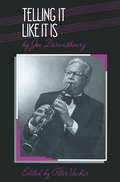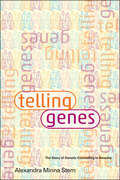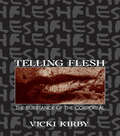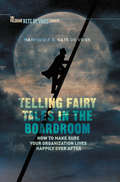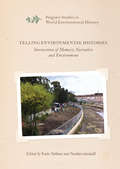- Table View
- List View
Telling Pieces: Art As Literacy in Middle School Classes
by Peggy Albers Sharon MurphyTelling Pieces is an exploration of how pre-adolescent middle-school children develop a knowledge and understanding of the conventions of art (art as literacy) and how they use this knowledge to create representations of their lives in a small midwestern U.S. town. Beginning with an overview of social semiotics and emergent literacy theorizing, the authors set the stage for their study of sixth graders involved in art. A galleria of children's artworks is presented, allowing readers/viewers to consider these texts independent of the authors' interpretations of them. Then, set against the galleria is the story of the community and school contexts in which the artworks are produced--contexts in which racism, homophobia, and the repression of creativity are often the norm. The interpretation the authors bring to bear on the artworks reveals stories that the artworks may or may not tell on their own. But the tales of artistic literacy achievement are counterbalanced by reflection about the content of the artworks produced, because the artworks reveal the impossibility for students to imagine beyond the situational bounds of racism, homophobia, and religiosity. The authors conclude by raising questions about the kinds of conditions that make literacy in art possible. In doing so, they explore selected alternative models and, in addition, ask readers to consider the implications of the ideological issues underlying teaching children how to represent their ideas. They also advocate for a participatory pedagogy of possibility founded on ethical relational principles in the creation and interpretation of visual text. Of particular interest to school professionals, researchers, and graduate students in literacy or art education, this pioneering book: * brings together the fields of art education and literacy education through its focus on how middle school students come to work with and understand the semiotic systems, * introduces sociolinguistic, sociological, and postmodernist perspectives to thinking about children's work with art--adding a new dimension to the psychological and developmental descriptions that have tended to dominate thinking in the field, * includes a galleria of 40 examples of children's artwork, providing a unique opportunity for readers/viewers to interpret and consider the artwork of the sixth graders independent of the authors' interpretations, * presents descriptions of art teaching in process, * gives considerable attention to the interpretation of the children's artworks and the influences that contribute to the content they represent, and * considers varying models of art education along with the implications of introducing new representational possibilities.
Telling People What to Think: Early Eighteenth Century Periodicals from the Review to the Rambler
by Thomas Corns J. A. DownieThis collection of essays displays a number of different approaches to the most significant early eighteenth-century periodicals. The range is considerable: the critique of ideology and polemical strategy, the political history of the press, the rhetoric of the genre, and the material circumstances of periodical production all find a place. The periodical profoundly shaped the English reading public's ways of perceiving the social and political institutions of their own age.
Telling People What to Think: Early Eighteenth Century Periodicals from the Review to the Rambler
by J. A. Downie Thomas N. CornsThis collection of essays displays a number of different approaches to the most significant early eighteenth-century periodicals. The range is considerable: the critique of ideology and polemical strategy, the political history of the press, the rhetoric of the genre, and the material circumstances of periodical production all find a place. The periodical profoundly shaped the English reading public's ways of perceiving the social and political institutions of their own age.
Telling Our Stories of Home: International Performance Pieces By and About Women
by Kathy A. PerkinsWhat is home? The answer seems obvious. But Telling Our Stories of Home, an international collection of eleven plays by and about women from Lebanon, Haiti, Venezuela, Uganda, Palestine, Brazil, India, UK, and the US, complicates the answer. The "answer" includes stories as far-ranging as: enslaved women trying to create a home, one by any means necessary, and one in the ocean; siblings wrestling with their differing devotion to home after their mother's death; a family wrestling with the government's refusal to allow the burial of their soldier-son in their hometown; a young scholar attempting to feel at home after studying abroad; a young man fleeing home due to his sexual orientation only to discover the difficulty of creating home elsewhere, and Siddis (Indians of African descent) continuing to struggle for acceptance despite having lived in India for over 600 years. These are voices seldom represented to a larger audience. The plays and performance pieces range from 20 to 90-minute pieces and include a mix of monologue, duologue, and ensemble plays. Short yet powerful, they allow fantastic performance opportunities particularly in an age of social-distancing with flexible casts that together invite the theme of home to be performed and studied on the page. The plays include: The House by Arzé Khodr (Lebanon), Happy by Kia Corthron (US), The Blue of the Island by Évelyne Trouillot (Haiti), Nine Lives by Zodwa Nyoni (UK), Leaving, but Can't Let Go by Lupe Gehrenbeck (Venezuela), Questions of Home by Doreen Baingana (Uganda), On the Last Day of Spring by Fidaa Zidan (Palestine) Letting Go and Moving On by Louella Dizon San Juan (US), Antimemories of an Interrupted Trip by Aldri Anunciação (Brazil), So Goes We by Jacqueline E. Lawton (US), and Those Who Live Here, Those Who Live There by Geeta P. Siddi and Girija P. Siddi (India)
Telling Our Stories of Home: International Performance Pieces By and About Women
What is home? The answer seems obvious. But Telling Our Stories of Home, an international collection of eleven plays by and about women from Lebanon, Haiti, Venezuela, Uganda, Palestine, Brazil, India, UK, and the US, complicates the answer. The "answer" includes stories as far-ranging as: enslaved women trying to create a home, one by any means necessary, and one in the ocean; siblings wrestling with their differing devotion to home after their mother's death; a family wrestling with the government's refusal to allow the burial of their soldier-son in their hometown; a young scholar attempting to feel at home after studying abroad; a young man fleeing home due to his sexual orientation only to discover the difficulty of creating home elsewhere, and Siddis (Indians of African descent) continuing to struggle for acceptance despite having lived in India for over 600 years. These are voices seldom represented to a larger audience. The plays and performance pieces range from 20 to 90-minute pieces and include a mix of monologue, duologue, and ensemble plays. Short yet powerful, they allow fantastic performance opportunities particularly in an age of social-distancing with flexible casts that together invite the theme of home to be performed and studied on the page. The plays include: The House by Arzé Khodr (Lebanon), Happy by Kia Corthron (US), The Blue of the Island by Évelyne Trouillot (Haiti), Nine Lives by Zodwa Nyoni (UK), Leaving, but Can't Let Go by Lupe Gehrenbeck (Venezuela), Questions of Home by Doreen Baingana (Uganda), On the Last Day of Spring by Fidaa Zidan (Palestine) Letting Go and Moving On by Louella Dizon San Juan (US), Antimemories of an Interrupted Trip by Aldri Anunciação (Brazil), So Goes We by Jacqueline E. Lawton (US), and Those Who Live Here, Those Who Live There by Geeta P. Siddi and Girija P. Siddi (India)
Telling Our Stories: Continuities and Divergences in Black Autobiographies
by A. AlabiTelling Our Stories investigates the continuities and divergences in selected Black autobiographies from Africa, the Caribbean, and the United States. The stories of slaves, creative writers, and political activists are discussed both as texts produced by individuals who are products of specific societies and as interconnected books. The book identifies influences of environmental and cultural differences on the texts while it adopts cross-cultural and postcolonial reading approaches to examine the continuities and divergences in them.
Telling Our Selves: Ethnicity and Discourse in Southwestern Alaska (Oxford Studies in Anthropological Linguistics)
by Chase HenselIn this book, Chase Hensel examines how Yup'ik Eskimos and non-natives construct and maintain gender and ethnic identities through strategic talk about hunting, fishing, and processing. Although ethnicity is overtly constructed in terms of either/or categories, the discourse of Bethel residents suggests that their actual concern is less with whether one is native or non-native, than with how native one is in a given context. In the interweaving of subsistence practices and subsistence discourse, ethnicity is constantly recreated.
Telling Others: The Alpha Initiative (ALPHA BOOKS)
by Nicky Gumbel'What distinguishes Alpha from other initiatives is the easy going, relaxed feel of the proceedings - that and its astonishing success.' - The TimesTelling Others imparts the vision, excitement and challenge of Alpha, with a practical guide to running a successful course. Perfect as a resource for churches, the book details the principles and structure of Alpha, tips on hosting small groups and giving talks, and guidance on pastoral care. A series of appendices provides suggestions for practicalities such as administration and running daytime and workplace courses, and advice on avoiding common mistakes and pitfalls. The chapters are interspersed with testimonies, written in their own words, from people whose lives have been changed by God through Alpha.
Telling Maya Tales: Tzotzil Identities in Modern Mexico
by Gary H. GossenTelling Maya Tales offers an experimental ethnographic portrait of the San Juan Chamula, the largest and most influential Maya community of Highland Chiapas, in the late twentieth century--the era of the Zapatistas. In this collection of essays, the author, whose field work in the area spans two generations of anthropological thought, explores several expressions of Tzotzil ethnic affirmation, ranging from oral narrative to ritual drama and political action. His work covers the current era, when the Chamula Tzotzils mingle chaotically and sometimes violently with the social and political space of modern Mexico--most recently, in the context of the Maya Zapatista movement of 1994.
Telling Maya Tales: Tzotzil Identities in Modern Mexico
by Gary H. GossenTelling Maya Tales offers an experimental ethnographic portrait of the San Juan Chamula, the largest and most influential Maya community of Highland Chiapas, in the late twentieth century--the era of the Zapatistas. In this collection of essays, the author, whose field work in the area spans two generations of anthropological thought, explores several expressions of Tzotzil ethnic affirmation, ranging from oral narrative to ritual drama and political action. His work covers the current era, when the Chamula Tzotzils mingle chaotically and sometimes violently with the social and political space of modern Mexico--most recently, in the context of the Maya Zapatista movement of 1994.
Telling Lives: Exploring dimensions of narratives
by Marianne HorsdalBoth interest in and understanding of narrative analysis had developed rapidly in recent years and is now a mainstream element of research across many disciplines. In the groundbreaking Telling Lives: Exploring dimensions of narratives, the author illustrates as many facets as possible of the stories people tell about their lives. She demonstrates
Telling Lives: Exploring dimensions of narratives
by Marianne HorsdalBoth interest in and understanding of narrative analysis had developed rapidly in recent years and is now a mainstream element of research across many disciplines. In the groundbreaking Telling Lives: Exploring dimensions of narratives, the author illustrates as many facets as possible of the stories people tell about their lives. She demonstrates
Telling It Like It Wasn’t: The Counterfactual Imagination in History and Fiction
by Catherine GallagherInventing counterfactual histories is a common pastime of modern day historians, both amateur and professional. We speculate about an America ruled by Jefferson Davis, a Europe that never threw off Hitler, or a second term for JFK. These narratives are often written off as politically inspired fantasy or as pop culture fodder, but in Telling It Like It Wasn’t, Catherine Gallagher takes the history of counterfactual history seriously, pinning it down as an object of dispassionate study. She doesn’t take a moral or normative stand on the practice, but focuses her attention on how it works and to what ends—a quest that takes readers on a fascinating tour of literary and historical criticism. Gallagher locates the origins of contemporary counterfactual history in eighteenth-century Europe, where the idea of other possible historical worlds first took hold in philosophical disputes about Providence before being repurposed by military theorists as a tool for improving the art of war. In the next century, counterfactualism became a legal device for deciding liability, and lengthy alternate-history fictions appeared, illustrating struggles for historical justice. These early motivations—for philosophical understanding, military improvement, and historical justice—are still evident today in our fondness for counterfactual tales. Alternate histories of the Civil War and WWII abound, but here, Gallagher shows how the counterfactual habit of replaying the recent past often shapes our understanding of the actual events themselves. The counterfactual mode lets us continue to envision our future by reconsidering the range of previous alternatives. Throughout this engaging and eye-opening book, Gallagher encourages readers to ask important questions about our obsession with counterfactual history and the roots of our tendency to ask “What if…?”
Telling It Like It Wasn’t: The Counterfactual Imagination in History and Fiction
by Catherine GallagherInventing counterfactual histories is a common pastime of modern day historians, both amateur and professional. We speculate about an America ruled by Jefferson Davis, a Europe that never threw off Hitler, or a second term for JFK. These narratives are often written off as politically inspired fantasy or as pop culture fodder, but in Telling It Like It Wasn’t, Catherine Gallagher takes the history of counterfactual history seriously, pinning it down as an object of dispassionate study. She doesn’t take a moral or normative stand on the practice, but focuses her attention on how it works and to what ends—a quest that takes readers on a fascinating tour of literary and historical criticism. Gallagher locates the origins of contemporary counterfactual history in eighteenth-century Europe, where the idea of other possible historical worlds first took hold in philosophical disputes about Providence before being repurposed by military theorists as a tool for improving the art of war. In the next century, counterfactualism became a legal device for deciding liability, and lengthy alternate-history fictions appeared, illustrating struggles for historical justice. These early motivations—for philosophical understanding, military improvement, and historical justice—are still evident today in our fondness for counterfactual tales. Alternate histories of the Civil War and WWII abound, but here, Gallagher shows how the counterfactual habit of replaying the recent past often shapes our understanding of the actual events themselves. The counterfactual mode lets us continue to envision our future by reconsidering the range of previous alternatives. Throughout this engaging and eye-opening book, Gallagher encourages readers to ask important questions about our obsession with counterfactual history and the roots of our tendency to ask “What if…?”
Telling It Like It Wasn’t: The Counterfactual Imagination in History and Fiction
by Catherine GallagherInventing counterfactual histories is a common pastime of modern day historians, both amateur and professional. We speculate about an America ruled by Jefferson Davis, a Europe that never threw off Hitler, or a second term for JFK. These narratives are often written off as politically inspired fantasy or as pop culture fodder, but in Telling It Like It Wasn’t, Catherine Gallagher takes the history of counterfactual history seriously, pinning it down as an object of dispassionate study. She doesn’t take a moral or normative stand on the practice, but focuses her attention on how it works and to what ends—a quest that takes readers on a fascinating tour of literary and historical criticism. Gallagher locates the origins of contemporary counterfactual history in eighteenth-century Europe, where the idea of other possible historical worlds first took hold in philosophical disputes about Providence before being repurposed by military theorists as a tool for improving the art of war. In the next century, counterfactualism became a legal device for deciding liability, and lengthy alternate-history fictions appeared, illustrating struggles for historical justice. These early motivations—for philosophical understanding, military improvement, and historical justice—are still evident today in our fondness for counterfactual tales. Alternate histories of the Civil War and WWII abound, but here, Gallagher shows how the counterfactual habit of replaying the recent past often shapes our understanding of the actual events themselves. The counterfactual mode lets us continue to envision our future by reconsidering the range of previous alternatives. Throughout this engaging and eye-opening book, Gallagher encourages readers to ask important questions about our obsession with counterfactual history and the roots of our tendency to ask “What if…?”
Telling It Like It Wasn’t: The Counterfactual Imagination in History and Fiction
by Catherine GallagherInventing counterfactual histories is a common pastime of modern day historians, both amateur and professional. We speculate about an America ruled by Jefferson Davis, a Europe that never threw off Hitler, or a second term for JFK. These narratives are often written off as politically inspired fantasy or as pop culture fodder, but in Telling It Like It Wasn’t, Catherine Gallagher takes the history of counterfactual history seriously, pinning it down as an object of dispassionate study. She doesn’t take a moral or normative stand on the practice, but focuses her attention on how it works and to what ends—a quest that takes readers on a fascinating tour of literary and historical criticism. Gallagher locates the origins of contemporary counterfactual history in eighteenth-century Europe, where the idea of other possible historical worlds first took hold in philosophical disputes about Providence before being repurposed by military theorists as a tool for improving the art of war. In the next century, counterfactualism became a legal device for deciding liability, and lengthy alternate-history fictions appeared, illustrating struggles for historical justice. These early motivations—for philosophical understanding, military improvement, and historical justice—are still evident today in our fondness for counterfactual tales. Alternate histories of the Civil War and WWII abound, but here, Gallagher shows how the counterfactual habit of replaying the recent past often shapes our understanding of the actual events themselves. The counterfactual mode lets us continue to envision our future by reconsidering the range of previous alternatives. Throughout this engaging and eye-opening book, Gallagher encourages readers to ask important questions about our obsession with counterfactual history and the roots of our tendency to ask “What if…?”
Telling It Like It Wasn’t: The Counterfactual Imagination in History and Fiction
by Catherine GallagherInventing counterfactual histories is a common pastime of modern day historians, both amateur and professional. We speculate about an America ruled by Jefferson Davis, a Europe that never threw off Hitler, or a second term for JFK. These narratives are often written off as politically inspired fantasy or as pop culture fodder, but in Telling It Like It Wasn’t, Catherine Gallagher takes the history of counterfactual history seriously, pinning it down as an object of dispassionate study. She doesn’t take a moral or normative stand on the practice, but focuses her attention on how it works and to what ends—a quest that takes readers on a fascinating tour of literary and historical criticism. Gallagher locates the origins of contemporary counterfactual history in eighteenth-century Europe, where the idea of other possible historical worlds first took hold in philosophical disputes about Providence before being repurposed by military theorists as a tool for improving the art of war. In the next century, counterfactualism became a legal device for deciding liability, and lengthy alternate-history fictions appeared, illustrating struggles for historical justice. These early motivations—for philosophical understanding, military improvement, and historical justice—are still evident today in our fondness for counterfactual tales. Alternate histories of the Civil War and WWII abound, but here, Gallagher shows how the counterfactual habit of replaying the recent past often shapes our understanding of the actual events themselves. The counterfactual mode lets us continue to envision our future by reconsidering the range of previous alternatives. Throughout this engaging and eye-opening book, Gallagher encourages readers to ask important questions about our obsession with counterfactual history and the roots of our tendency to ask “What if…?”
Telling It Like It Wasn’t: The Counterfactual Imagination in History and Fiction
by Catherine GallagherInventing counterfactual histories is a common pastime of modern day historians, both amateur and professional. We speculate about an America ruled by Jefferson Davis, a Europe that never threw off Hitler, or a second term for JFK. These narratives are often written off as politically inspired fantasy or as pop culture fodder, but in Telling It Like It Wasn’t, Catherine Gallagher takes the history of counterfactual history seriously, pinning it down as an object of dispassionate study. She doesn’t take a moral or normative stand on the practice, but focuses her attention on how it works and to what ends—a quest that takes readers on a fascinating tour of literary and historical criticism. Gallagher locates the origins of contemporary counterfactual history in eighteenth-century Europe, where the idea of other possible historical worlds first took hold in philosophical disputes about Providence before being repurposed by military theorists as a tool for improving the art of war. In the next century, counterfactualism became a legal device for deciding liability, and lengthy alternate-history fictions appeared, illustrating struggles for historical justice. These early motivations—for philosophical understanding, military improvement, and historical justice—are still evident today in our fondness for counterfactual tales. Alternate histories of the Civil War and WWII abound, but here, Gallagher shows how the counterfactual habit of replaying the recent past often shapes our understanding of the actual events themselves. The counterfactual mode lets us continue to envision our future by reconsidering the range of previous alternatives. Throughout this engaging and eye-opening book, Gallagher encourages readers to ask important questions about our obsession with counterfactual history and the roots of our tendency to ask “What if…?”
Telling It Like It Is
by Joe Darensbourg Peter VacherThe autobiography of one of the foremost jazz clarinetists who is well known for his recordings with Edward 'Kid' Ory and the Louis Armstrong All Stars. Darensbourg was born in Baton Rouge, LA, in 1906 and heard many early New Orleans jazz bands as a young boy. For most of his life he lived on the West Coast and the book is a first-rate reference source for students of jazz and popular music in the urban centres of Seattle and Los Angeles.
Telling Genes: The Story of Genetic Counseling in America
by Alexandra Minna SternFor sixty years genetic counselors have served as the messengers of important information about the risks, realities, and perceptions of genetic conditions. More than 2,500 certified genetic counselors in the United States work in clinics, community and teaching hospitals, public health departments, private biotech companies, and universities. Telling Genes considers the purpose of genetic counseling for twenty-first century families and society and places the field into its historical context.Genetic counselors educate physicians, scientific researchers, and prospective parents about the role of genetics in inherited disease. They are responsible for reliably translating test results and technical data for a diverse clientele, using scientific acumen and human empathy to help people make informed decisions about genomic medicine.Alexandra Minna Stern traces the development of genetic counseling from the eugenics movement of the early twentieth century to the current era of human genomics. Drawing from archival records, patient files, and oral histories, Stern presents the fascinating story of the growth of genetic counseling practices, principles, and professionals.
Telling Flesh: The Substance of the Corporeal
by Vicki KirbyFirst Published in 1997. Routledge is an imprint of Taylor & Francis, an informa company.
Telling Flesh: The Substance of the Corporeal
by Vicki KirbyFirst Published in 1997. Routledge is an imprint of Taylor & Francis, an informa company.
Telling Fairy Tales in the Boardroom: How to Make Sure Your Organization Lives Happily Ever After (INSEAD Business Press)
by Manfred F.R. Kets de VriesWe know where we are with a fairy story. There is a cast of predictable characters, the hero or heroine is submitted to terrible trials, cruelty, and injustice but in the end the baddies get their comeuppance, good triumphs, and everyone lives happily ever after. In this book Manfred Kets de Vries, one of the world's leading authorities on the psychology of leadership, and a pioneering practitioner in the field of psychodynamic executive coaching, draws on the format of traditional fairy tales and tells us five stories that dramatize five key themes of dysfunctional leadership. The accompanying commentaries analyze each tale and examine the ways in which it applies to leadership behavior and organizational practices. This diagnostic element is supported by self-assessment tests that reinforce the main lessons of each tale and guide the reader's interpretation of the results. With Kets de Vries's guidance you'll be able to help your clients create best places to work, where everyone is the best they can be, and lives 'happily ever after'.
Telling Environmental Histories: Intersections of Memory, Narrative and Environment (Palgrave Studies in World Environmental History)
by Katie Holmes Heather GoodallThis collection explores the intersections of oral history and environmental history. Oral history offers environmental historians the opportunity to understand the ways people’s perceptions, experiences and beliefs about environments change over time. In turn, the insights of environmental history challenge oral historians to think more critically about the ways an active, more-than-human world shapes experiences and people. The integration of these approaches enables us to more fully and critically understand the ways cultural and individual memory and experience shapes human interactions with the more-than-human world, just as it enables us to identify the ways human memory, identity and experience is moulded by the landscapes and environments in which people live and labour. It includes contributions from Australia, India, the UK, Canada and the USA.
